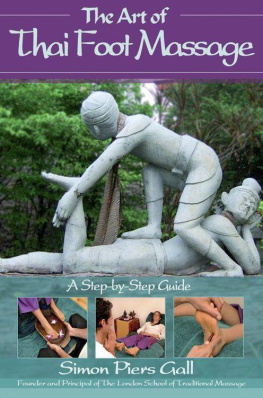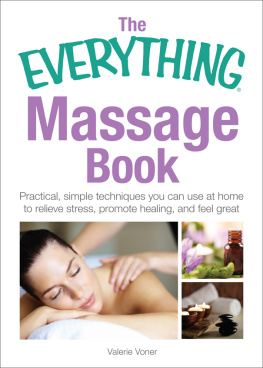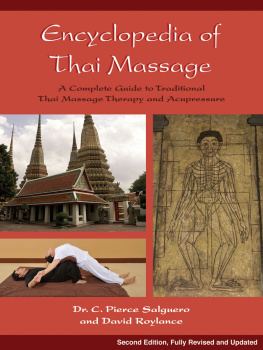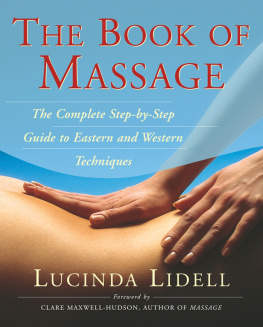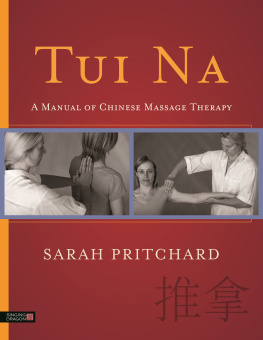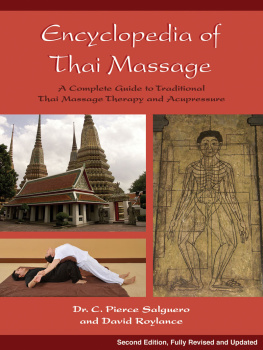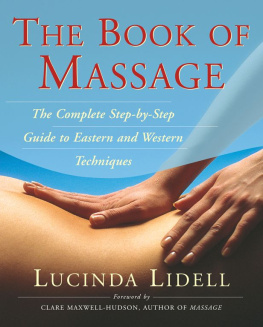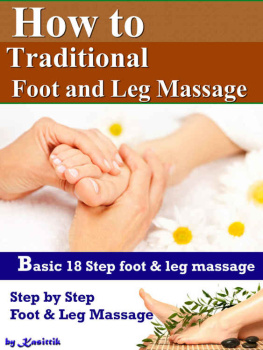Neither the publisher nor the author is engaged in rendering professional advice or services to the individual reader. The ideas, procedures, and suggestions contained in this book are not intended as a substitute for consulting with your physician. All matters regarding health require medical supervision. Neither the author nor the publisher shall be liable or responsible for any loss, injury, or damage allegedly arising from any information or suggestion in this book. The opinions expressed in this book represent the personal views of the author and not of the publisher.
Preface
I first travelled to Thailand hoping to learn a few techniques to incorporate into my existing sports massage practice. A friend had shown me a few Thai techniques that impressed me so much I immediately began to plan my trip to Thailand. This first trip was a revelation to me. Traditional Thai Massage seemed to be the perfect sports massage. The physical aspect to Thai Massage is undeniable, every joint is mobilised, every muscle is stretched and compressed in a way that has to be experienced to be appreciated, and all performed with such apparent ease by the therapist. Nearly ten years later I am still convinced that Thai Massage is the perfect sports massage; however it is also much more. As well as massaging the physical body, Traditional Thai Massage takes a holistic approach encompassing the mind, body and spirit.
As a therapist my intention was holistic, however the training I had chosen was always physical in its approach. I had begun to search for the more holistic approaches to health and well-being and was studying as a yoga teacher. I particularly enjoyed pranayama , or breathing techniques, and had begun incorporating vinyasa , combining breath with movement, into other areas of my work. Thai Massage fascinated me from the outset with its physical yet meditative approach. It combined yoga postures with massage techniques and breath work. I was immediately hooked and my interest has only increased since this first revelation. What began as a search for a few techniques to incorporate into my practice, has instead completely changed my approach, sparking an interest in all aspects of Traditional Thai Medicine, of which Thai Massage is an integral part.
After this first trip to Thailand I almost immediately returned to continue my studies. It was between these first two trips that I had my first reflexology treatment and became fascinated with the feet and also the first time I met my partner Paula. I had heard ofreflexology and seen much Thai Foot Massage whilst in Thailand. I knew that it worked reflex points on the feet in order to affect the internal organs of the body, but I had never had a reflexology treatment. It wasnt that I doubted the effectiveness of the treatment, just that I preferred the physical effects of a full body massage.
Whilst waiting to return to Thailand I visited my local Complementary Therapy Centre to extol the virtues of Thai Massage and see if I could work as a therapist there. I met with the proprietor, Paula Lloyd, who was a reflexology practitioner and tutor with the ARC reflexology school. Paula seemed interested in Thai Massage and so we arranged to swap treatments. Having kept my end of the bargain I was thoroughly enjoying my reflexology treatment and fascinated by Paulas commentary throughout. The majority of the treatment was very pleasant and relaxing, except for one point where it felt like a needle was being applied to my foot. When I told Paula what I was feeling she explained that this point related to my ear. I had been experiencing constant discomfort with my ear since going scuba diving in Thailand and as I explained this to Paula, she continued to work on this area and eventually the pain died down.
After the treatment I carried on with my day thinking more about the reflexologist than the reflexology treatment. As the day wore on I noticed that when I swallowed or yawned the annoying popping sensation in my ear had subsided, and then, the next day it had gone completely, and has never recurred. After this one treatment I decided two things: to study Thai Foot Massage on my next and imminent trip to Thailand, and to get to know Paula better. I think I have managed both, as Paula and I have been together ever since and I am eternally grateful for the direction and motivation she has given me, as well as her expert knowledge that has been invaluable in writing this book.
I have had the honour and privilege of training with some great Thai teachers and Masters of Traditional Thai Massage and my thanks go to Chongkol Setthakorn, Somphat, Mama Lek, Jack Chaiya, Nit Chaimonkol, Pichest Boonthume, the staff at the Old Medicine Hospital in Chiang Mai and TMC Chiang Mai, as well as the staff at Wat Pho. To these teachers I am very grateful along with the many Thai therapists who have shown me much along the way, especially Atchalee Siriwan (Angie) for her help and friendship.
My only Western teacher of Thai Massage was a German man by the name of Harald Brust, better known as Asokanada or Ashoka. Ashoka wrote the first book in the English language on Traditional Thai Massage called The Art of Traditional Thai Massage. I have borrowed his title for this book as a dedication to Ashoka, and also, as at the time of writing, this is the first book in English on Thai Foot Massage. Ashoka was an incredible man who elevated his own practice of Thai Massage to an art form, and was an inspiration to many. As neither a leader, nor a follower I found myself surprised at the strength of my desire to follow Ashoka. I had intended to study with him for a few days whilst he was in London, and a few days turned into a couple of weeks, but this was still not enough. When he left I immediately began to plan more training with him. It took over a year to organise, but I eventually managed to take my family halfway around the world to New Zealand where he lived. Ashoka had warned me that he was unwell, but when I arrived he was very weak and terminally ill with cancer. Ashoka had cut short a vipasana meditation retreat that he did every year for a month in the jungles of Thailand, as he found himself too ill to continue. He was later diagnosed with cancer and there was to be no cure or remission. After his death I was training with Pichest, an incredibly gifted Thai Massage therapist who still taught in the old oral tradition. Pichest was one of Ashokas teachers and explained to me that there are many strong spirits in the jungle and that these spirits had caused Ashokas illness. When a very weak Ashoka made the journey to Thailand to speak with Pichest and seek some treatment advice Pichest recommended a local Shamanic woman known as the egg lady, who could remove these spirits from Ashoka. This was not the advice Ashoka was looking for and decided not to go. There was to be no second chance, or chance to reconsider, as both the egg lady and Ashoka passed away a few weeks later.

